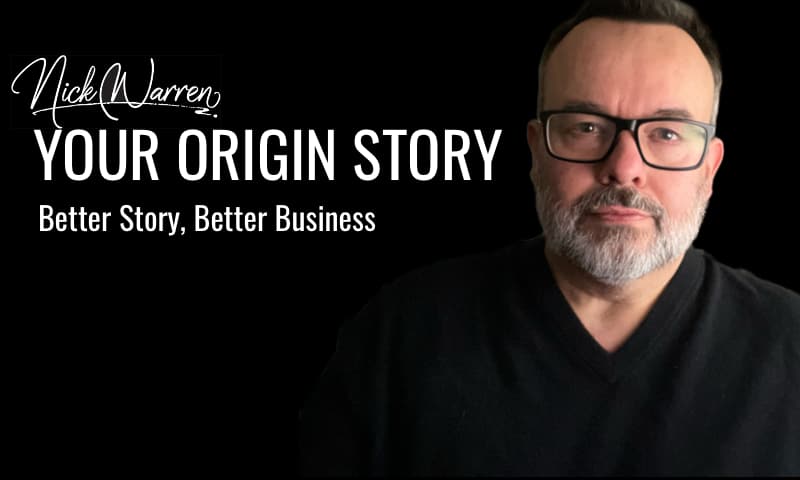If there’s one sentence on this page that makes my heart glad, it’s this … “People pay a premium for a story, every time.” What story are you telling?
If you’re not happy with the story consumers are telling themselves, the issue is the story itself. The story you are spreading.
Small Is The New Big (2006) – Seth Godin
Marketing has always been about discovering what people want and need, and telling them a story about how they can get it (from you).
Meatball Sundae (2008) – Seth Godin
Marketers of successful ideas rarely market the facts.
Instead, they market stories that match the worldview of the people being marketed to. There’s an alternative, one that you might want to think hard about: perhaps you should market your idea only to people who already think the way you do. After all, you’re not running for president; you don’t need a majority. Screen people by their behavior (what they read, what they buy, how they act) and tell your story to only the people who will embrace it. Doing that is a lot easier than it’s ever been before.
Whatcha Gonna Do with That Duck?: And Other Provocations (2013) – Seth Godin
Too often, marketers take a product and try to invent a campaign. Much more effective is to find a tribe, find a story, and make a product that resonates, one that makes the story work.
That’s the whole thing. A story that resonates and a tribe that’s tight and small and eager.
Whatcha Gonna Do with That Duck?: And Other Provocations (2013) – Seth Godin
Part of the work of design and marketing is to help people understand that there are no good substitutes for what you have to offer, meaning, of course, that you can happily charge more.
Whatcha Gonna Do with That Duck?: And Other Provocations (2013) – Seth Godin
“People pay a premium for a story, every time”
Whatcha Gonna Do with That Duck?: And Other Provocations (2013) – Seth Godin
Marketing (the use of time and money to create a story and spread it) works.
Whatcha Gonna Do with That Duck?: And Other Provocations (2013) – Seth Godin
Godin reinforces what good marketers know. – New York Times.
I’m flattered! I wasn’t sure I knew what every good marketer knows. I guess I do now. After all, the paper of record said so. But, assuming that you’re like me and the rest of the people I know (which means you haven’t figured out everything there is to know about marketing yet), here’s a list to get you started.
Good Marketers:
- Anticipated, personal, and relevant advertising always does better than unsolicited junk.
- Making promises and keeping them is a great way to build a brand.
- Your best customers are worth far more than your average customers.
- Share of wallet is easier, more profitable, and ultimately more effective a measure of success than share of market.
- Marketing begins before the product is created.
- Advertising is just a symptom, a tactic. Marketing is about far more than that.
- Low price is a great way to sell a commodity. That’s not marketing, though, that’s efficiency.
- Conversations among the people in your marketplace happen whether you like it or not. Good marketing encourages the right sort of conversations.
- Products that are remarkable inspire conversation.
- Marketing is the way your people answer the phone, the typesetting on your bills, and your returns policy.
- You can’t fool all the people, not even most of the time. And once they catch you, people talk about the experience.
- If you are marketing from a fairly static annual budget, you’re viewing marketing as an expense. Good marketers realize that it is an investment.
- People don’t buy what they need. They buy what they want.
- You’re not in charge. And your prospects don’t care about you. What people want is the extra, emotional bonus they get when they buy something they love.
- Business-to-business marketing is just marketing to consumers who happen to have a corporation to pay for what they buy.
- Traditional ways of interrupting consumers (TV ads, trade show booths, junk mail) are losing their cost-effectiveness. At the same time, new ways of spreading ideas (blogs, permission – based RSS information, consumer fan clubs) are quickly proving how well they work.
- People all over the world, and of every income level, respond to marketing that promises and delivers basic human wants.
- Good marketers tell a story.
- People are selfish, lazy, uninformed, and impatient. Start with that and you’ll be pleasantly surprised by what you find.
- Marketing that works is marketing that people choose to notice.
- Effective stories match the worldview of the people you are telling the story to.
- Choose your customers. Fire the ones that hurt your ability to deliver the right story to the others.
- A product for everyone rarely reaches anyone.
- Living and breathing an authentic story is the best way to survive in a conversation – rich world.
- Marketers are also responsible for the side effects their products cause.
- Reminding the consumer of a story they know and trust is a powerful shortcut.
- Good marketers measure.
- Marketing is not an emergency. It’s a planned, thoughtful exercise that started a long time ago and doesn’t end until you’re done.
- One disappointed customer is worth as much as ten delighted ones.
Whatcha Gonna Do with That Duck?: And Other Provocations (2013) – Seth Godin
For most of my lifetime, marketing was advertising. And then it wasn’t true anymore. Which means you’ll need to become a marketer instead. That means seeing what others see. Building tension. Aligning with tribes. Creating ideas that spread. It means doing the hard work of becoming driven by the market and working with (your part of) that market.
This Is Marketing: You Can’t Be Seen Until You Learn To See (2018) – Seth Godin
Marketing in five steps
- The first step is to invent a thing worth making, with a story worth telling, and a contribution worth talking about.
- The second step is to design and build it in a way that a few people will particularly benefit from and care about.
- The third step is to tell a story that matches the built-in narrative and dreams of that tiny group of people, the smallest viable market.
- The fourth step is the one everyone gets excited about: spread the word.
- The last step is often overlooked: show up—regularly, consistently, and generously, for years and years—to organize and lead and build confidence in the change you seek to make. To earn permission to follow up and to earn enrollment to teach.
As marketers, we get to consistently do the work to help the idea spread from person to person, engaging a tribe as you make change happen.
This Is Marketing: You Can’t Be Seen Until You Learn To See (2018) – Seth Godin
See Also:
On Attention | On Authenticity | On Average | On Branding | On Challenging Yourself | On Foundations | On Humans | On Ideaviriuses | On Intangibles | On Leadership | On Niching | On Oxymorons | On Permission | On Pricing | On Selling
Or choose a path towards stories that mean business.

Explore the art and science of business storytelling. The rabbit hole goes way deeper than you think.

The Business Storytelling Glossary lists the concepts, ideas and definitions that use in my work. Your mileage will vary.

